
Paro, Bhutan
Encyclopedia
Paro is a town
and seat of Paro District
in the Paro Valley of Bhutan
.


 Rinpung Dzong
Rinpung Dzong
a fortress-monastery overlooking the Paro valley
has a long history. A monastery was first built on the site by Padma Sambhava at the beginning of the tenth century, but it wasn't until 1646 that Ngawang Namgyal
built a larger monastery on the old foundations, and for centuries this imposing five storey building served as an effective defence against numerous invasion attempts by the Tibet
ans.
Built with stones instead of clay, the Dzong was named Rinpung, meaning "heaps of jewels" but Rinpung and all its treasures were destroyed by the fire in 1907. Only one thangka, known as Thongdel, was saved. The Paro Dzong was rebuilt by the penlop dawa Penjor after the fire. Housed within its walls is a collection of sacred masks and costumes. Some date back several centuries; others were contributed by Dawa Penjor and his successor Penlop Tshering Penjor in recent times.
On the hill above the Dzong stands an ancient watchtower called Ta Dzong which since 1967, has been the National Museum of Bhutan. Across a medieval bridge below the Dzong stands the Ugyenpelri Palace, a royal residence constructed by penlop Tshering Penjor.


 Along the main street there is a complex of traditional architecture with richly decorated buildings housing small shops, institutions and restaurants.
Along the main street there is a complex of traditional architecture with richly decorated buildings housing small shops, institutions and restaurants.
The Dungtse Lhakhang is a 15th century temple situated by the new bridge, and the Ugyen Perli Palace is visible through the fence. Members of royal family lodge in the palace when passing. Nearby is the old bridge by the Rinpung Dzong. Notable hotels include the Olathang Hotel built in an ornate style.
10 km outside Paro is the famous Taktshang (Tiger’s Nest) Hermitage on the face of a sheer 1000m cliff. The place is highly sacred to the Bhutanese in that they believe Guru Rinpoche, the father of Bhutanese Buddhism landed here on the back of tigress. A 16 km road passes up the valley to the ruins of other fortress-monastery Drukyel Dzong, partly destroyed by fire in 1951.
Town
A town is a human settlement larger than a village but smaller than a city. The size a settlement must be in order to be called a "town" varies considerably in different parts of the world, so that, for example, many American "small towns" seem to British people to be no more than villages, while...
and seat of Paro District
Paro District
Paro District is the name of a district , valley, river and town in Bhutan. It is one of the most historic valleys in Bhutan. Both trade goods and invading Tibetans came over the pass at the head of the valley, giving Paro the closest cultural connection with Tibet of any Bhutanese district...
in the Paro Valley of Bhutan
Bhutan
Bhutan , officially the Kingdom of Bhutan, is a landlocked state in South Asia, located at the eastern end of the Himalayas and bordered to the south, east and west by the Republic of India and to the north by the People's Republic of China...
.
History



Rinpung Dzong
Rinpung Dzong is a large Drukpa Kagyu Buddhist monastery and fortress in Paro District in Bhutan. It houses the district Monastic Body and government administrative offices of Paro Dzongkhag.-History:...
a fortress-monastery overlooking the Paro valley
Paro Chhu
The Paro Chhu is a river of western Bhutan. It is a tributary of the Wong Chhu, which is known as the Raidak in its lower reaches.-Course:...
has a long history. A monastery was first built on the site by Padma Sambhava at the beginning of the tenth century, but it wasn't until 1646 that Ngawang Namgyal
Ngawang Namgyal
Ngawang Namgyal was a Tibetan Buddhist lama and the unifier of Bhutan as a nation state...
built a larger monastery on the old foundations, and for centuries this imposing five storey building served as an effective defence against numerous invasion attempts by the Tibet
Tibet
Tibet is a plateau region in Asia, north-east of the Himalayas. It is the traditional homeland of the Tibetan people as well as some other ethnic groups such as Monpas, Qiang, and Lhobas, and is now also inhabited by considerable numbers of Han and Hui people...
ans.
Built with stones instead of clay, the Dzong was named Rinpung, meaning "heaps of jewels" but Rinpung and all its treasures were destroyed by the fire in 1907. Only one thangka, known as Thongdel, was saved. The Paro Dzong was rebuilt by the penlop dawa Penjor after the fire. Housed within its walls is a collection of sacred masks and costumes. Some date back several centuries; others were contributed by Dawa Penjor and his successor Penlop Tshering Penjor in recent times.
On the hill above the Dzong stands an ancient watchtower called Ta Dzong which since 1967, has been the National Museum of Bhutan. Across a medieval bridge below the Dzong stands the Ugyenpelri Palace, a royal residence constructed by penlop Tshering Penjor.
Architecture



The Dungtse Lhakhang is a 15th century temple situated by the new bridge, and the Ugyen Perli Palace is visible through the fence. Members of royal family lodge in the palace when passing. Nearby is the old bridge by the Rinpung Dzong. Notable hotels include the Olathang Hotel built in an ornate style.
10 km outside Paro is the famous Taktshang (Tiger’s Nest) Hermitage on the face of a sheer 1000m cliff. The place is highly sacred to the Bhutanese in that they believe Guru Rinpoche, the father of Bhutanese Buddhism landed here on the back of tigress. A 16 km road passes up the valley to the ruins of other fortress-monastery Drukyel Dzong, partly destroyed by fire in 1951.

